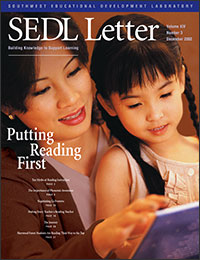Reading and the Migrant Student
 I arrive at 5 o’clock in the morning. While you are having your first dream, sweat washes my face, and I have bathed with fog in the long furrows. While you drop milk in the school’s kitchen, I wish I could drink a drop of water because it seems like I never reach the end of the row. . . . While you checked exams I revisited the fields, and sometimes I pulled out snakes instead of vegetables. . . .
I arrive at 5 o’clock in the morning. While you are having your first dream, sweat washes my face, and I have bathed with fog in the long furrows. While you drop milk in the school’s kitchen, I wish I could drink a drop of water because it seems like I never reach the end of the row. . . . While you checked exams I revisited the fields, and sometimes I pulled out snakes instead of vegetables. . . .
Yes, I’m a migrant. I study when I can so someday I can stop being poor and stop crying in the fields close to the town I never knew.
— Sandra Treviño, in Children of La Frontera
El otro lado is “the other side.” In the literal sense, it refers to the 2400-kilometer border between the United States and Mexico. Metaphorically, it speaks to the life experience of migrant farmworkers who are carving a place for themselves and their families in the sociopolitical and cultural economies of the United States. What happens to the children of these people on the other side? La frontera is the borderland. Perhaps better than the melting pot, it describes the confluence of peoples and cultures occurring in the United States today. The migrant child continually negotiates this territory, moving between communities and cultures.
Our teachers need to be able to quickly assess a student's abilities and differentiate instruction accordingly, and a balanced literacy approach allows them to do that.
Poverty, health problems, discrimination, and language barriers have a dramatic impact on the educational achievement of children of migrant laborers. They share these conditions with many of the poorest populations in the United States today; however, the additional factor of high mobility creates a unique set of obstacles. Migrant students may attend as many as six or seven schools per year. They must not only adapt to new curriculum, sequencing, and procedures, but must also continually create new social ties and adjust to new school cultures. For those who are learning to read and write in any language, let alone one that may not be a first language, high mobility can have devastating effects. The consistency and intensity that are the hallmarks of quality reading instruction are much more difficult to attain. And without solid reading skills, a student will struggle throughout her years of schooling.
Successful reading strategies
Despite the odds, there are many success stories. One of these is Pringle-Morse Elementary and Middle School in Morse, Texas, where nearly one-quarter of the 112 students qualify for migrant status. Staff at Pringle-Morse focus primarily on early balanced literacy instruction. Early balanced literacy consists of explicit instruction in the nuts and bolts of reading — phonemic awareness, phonics, fluency, vocabulary, and comprehension — but in the context of meaningful engagements with print. In addition to group and independent activities, it includes guided work, which occurs in small groups of students with similar reading levels. The groupings are fluid, depending upon the teacher's assessment of each child's individual growth and changing instructional needs.
 "I have never had children write as well as they do and gain the self-confidence that they do with this approach," says one Pringle-Morse teacher. Gene Baird, superintendent at nearby Texline School District, believes that early balanced literacy is particularly effective with migrant students because of its high degree of individualization. "The one thing you can count on with our migrant students is that their education backgrounds will be widely dissimilar," says Baird. "Our teachers need to be able to quickly assess a student's abilities and differentiate instruction accordingly, and a balanced literacy approach allows them to do that."
"I have never had children write as well as they do and gain the self-confidence that they do with this approach," says one Pringle-Morse teacher. Gene Baird, superintendent at nearby Texline School District, believes that early balanced literacy is particularly effective with migrant students because of its high degree of individualization. "The one thing you can count on with our migrant students is that their education backgrounds will be widely dissimilar," says Baird. "Our teachers need to be able to quickly assess a student's abilities and differentiate instruction accordingly, and a balanced literacy approach allows them to do that."
Staff also note that Accelerated Reader, a commercially produced reading program that allows student selection of books and includes computerized assessments, has worked well with their migrant students. Those who use the program believe its reward system (points applied to prizes) encourages students to increase their reading skills.
These schools' successes can be attributed to many internal factors as well. For example, every teacher at Pringle-Morse has English as a Second Language certification to enable them to work better with the high number of English language learners in their school. Another factor in the success at both Texline and Pringle-Morse is their strong emphasis on parent involvement. Texline parents, for example, participate in such extracurricular activities as taking students on a rare field trip to the opera, and migrant parents are frequently found helping in the classroom during the summer migrant education program. Texline is also laying the groundwork for a formal parental involvement policy. Pringle-Morse holds three parent-teacher conferences per year in elementary school, with bilingual aides to assist Spanish-speaking parents. They are also exploring the possibility of implementing free English classes for parents.
More than anything, teachers at Pringle-Morse point to their community as their source of success. "Our community is a family," says Shannon Lane. "Our school is one of the few institutions in the area, and everyone is focused on the success of our students." Because community spirit is so strong, newly arrived parents have an immediate network of support and information that allows them to tap into available resources. This includes both education and health services, an important piece of the puzzle for families in hazardous farmworking occupations.
Additional strategies for success
"Good programs for migrant students look like good programs anywhere," says Caroline Wilkenson of RMC Research, a partner in the STAR Center (Support for Texas Academic Renewal), which is the state's Comprehensive Assistance Center. The same could be said of good teaching. There are common strategies to improve student literacy that can be employed across grade levels and programs that serve migrant students.
A teacher's first step may well need to be to helping students overcome their fears and insecurities about their performance. A recent publication, Literacy con Cariño, relates in a very personal way the story of the astounding success of a South Texas teacher with his migrant students
(Literacy con cariño: A story of migrant children’s success by Curtis W. Hayes, Robert Bahruth, and Carolyn Kessler. Portsmouth, NH: Heinemann ©1998.)
Migrant students are capable of achieving as much as any other students. The real challenge is to provide consistent, long-term reading instruction. Migrant program directors across states need to work to align instruction. Their role as advocates is to reach across states to really impact our kids.
This teacher introduced his students to writing by requiring them to journal every day, and every day he replied to what they wrote. Initially hesitant, students slowly responded to the dialoguing process and to the affirmation of their experience. They became confident writers who believed they could achieve in school and beyond. This teacher exhibits high expectations of his students, which some say can be the most critical piece of the achievement puzzle for migrant students. Wilkenson echoes this belief. "Perhaps the most important quality a teacher can bring to the migrant classroom is believing that kids are capable of thinking critically and achieving success. They can do it."
Integration and affirmation of the student's culture and lifestyle in the classroom is also of critical importance. Despite the hazards and extreme difficulties of the migrant lifestyle, migration also provides students with a unique set of skills and knowledge. Of necessity, for example, students work to acquire adaptive skills in new settings, an ability which is not as critical for less-mobile students. They learn to cope with the challenges of the road and develop pragmatic skills in problem solving. They also accumulate a broad base of knowledge in geographical and cultural diversity. Validating and utilizing these skills and this knowledge can begin to develop a student's sense of self-worth and confidence in the academic setting. For example, a teacher might have students write brief autobiographies at the beginning of a summer term, then integrate information from those pieces into such content areas as language arts, social studies, and science. She might also include culturally relevant materials in the classroom; a surprising wealth of literature related to the migrant experience is available at all reading levels.
As previously mentioned, parent involvement can have a dramatic impact on student achievement. In fact, the migrant education portion of No Child Left Behind strongly emphasizes family literacy and parental involvement and requires that it occur "in a format and language understandable to the parents." Teachers and administrators must be aware that the very concept of parental involvement may be new to some students and parents; given the traditional respect accorded to educators, parents may equate "involvement" with "interference." In addition, activities and expectations must reflect an awareness of the many demands on migrant farmworkers' time; flexibility and responsiveness are the hallmarks of successful parent involvement programs. Appropriate parental involvement activities might include daily or weekly checklists of their children's work and progress, sharing oral histories, or encouraging family literacy activities. Pringle-Morse has used some of its grant money to send a bilingual aide to each child's home during the summer, to read to students and discuss with parents strategies to improve their children's learning. Aides leave books for parents and children to read together.
Schools must also foster learning independence in their migrant students. While this is a skill that all students must acquire at some point to be successful, the migrant lifestyle forces it upon students at an earlier age and to a greater extent. Services and support available at one site may not be available at the next; students must be taught the difficult skill of seeking out knowledge and assistance of their own accord. This reality lends added credence to the importance of including parents in children's education in meaningful and concrete ways; they are, generally, the most consistent presence in the migrant student's life.
Finally, more must be done to coordinate programs across states. As Donna Marie Marlow, senior education program specialist with the Migrant Education Program at the U.S. Department of Education, observes, "Migrant students are capable of achieving as much as any other students. The real challenge is to provide consistent, long-term reading instruction. Migrant program directors across states need to work to align instruction. Their role as advocates is to reach across states to really impact our kids." Technology will play an increasingly important role in this respect, both in coordinating instruction and in supplying ready access to health and education-related student information for teachers, wherever they may be.
Migrant students are, perhaps, our children most in danger of being left behind. They exist on the very periphery of almost every system, be it political, economic, or social. If education is the door to these systems, then reading literacy is its key, helping to blur the line between este lado y el otro lado.
Strategies for literacy instruction with migrant students
- Create a positive environment by modeling respect for diversity and sharing experiences and values. Teachers can further foster a sense of safety and trust by assigning older students to act as mentors or buddies to new migrant students.
- Build on migrant students’ strengths by incorporating students’ culture and language into the curriculum. A curriculum that includes culturally relevant content enables migrant students to develop pride in their culture and learn content from a familiar cultural base.
- Personalize lessons with students’ experience. Drawing from students’ life experiences helps them to understand ideas and transfer them to other content. It can also enhance students’ self-esteem and confidence in a school environment.
- Develop students’ metacognitive learning strategies to help them become independent learners. If students learn to recognize when they are approaching a learning obstacle, they can learn strategies to overcome it.
- Implement appropriate assessment of language proficiency and academic needs.
- Conduct outreach in the parents’ home language to facilitate communication.
- Provide staff development to help teachers and other staff serve migrant students more effectively.
Excerpted from Menchaca, V. D., and J. A. Ruiz-Escalante (1995). Instructional strategies for migrant students. ERIC Digest. Charleston: ERIC Clearinghouse on Rural Education and Small Schools. (ERIC Document Reproduction Service No. ED 388 941) and DiCerbo, P. (2001); Why migrant education matters. Issue brief. Washington D.C.: National Clearinghouse for Bilingual Education.
Andrea Jachman is a Denver-based freelance writer and editor who specializes in the education and nonprofit sectors. She holds a master's degree in educational policy and administration from the University of Minnesota and previously worked in Tijuana, Mexico.
Next Article: Making Every Teacher a Reading Teacher: Putnam City Secondary Educators Work to Help Struggling Readers

